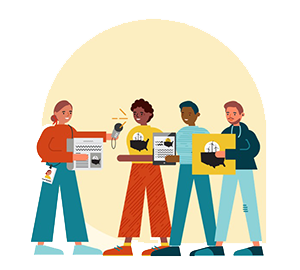Best Practices & Resources

-
Section 3
- Best Practices & Resources
-
Section 4
Tools, Tactics & Templates
-
Contact Us
Get help, give feedback, or share resources
Messaging at its simplest is how you tell your story.
Our Policy & Implementation Guide helps explain the language, but your campaign will need to relate these messages to your targets and audiences.
The 5 C’s of Good Messaging
If you haven’t checked out Comms 101, head there first. That’s where you’ll learn to hone your personal, campaign, and movement stories into an overall public narrative. This includes repeatedly addressing the 5 W’s: Who, What, Where, When, and Why.
But sometimes, as part of building that narrative, you’ll need to plan for single events or tactics, like speeches or presentations. The 5 C’s offer handy tips for staying on message and effectively getting your point across to your audience in those moments. Take a look:
Concise: Go directly to the point.
- Good: “100% renewable energy will keep our air and water clean.”
- Bad: “One thing that we really should do is try to convince our politicians to sign bills to convert to a country that uses 100% renewable energy. That way we will be able to ensure that all of our air that we breathe and water that we drink are clean and safe for all of us.”
Clear: Use stark language. Leave no doubt about whose side you’re on or what you want.
- Good:“We support the Plaintown Council endorsing a just transition to 100% clean, renewable energy community-wide by the year 2035.”
- Bad: “While we know that it will be a long and hard road to convert all of our energy to renewables, we think that it would be best for our city to try to make this happen.”
Consistent: Repeat, repeat, repeat. Choose three core messages and use them again and again.
- Good: A website with three pages outlining how 100% clean energy will improve health, save cost, and build community.
- Bad: A website that has long blocks of text about why clean energy is great for scores of reasons, embeds dozens of different studies about solar power, and has multiple links to other environmental missions.
Convincing: Make it compelling and meaningful. Look back at your community interviews and think about if this message connects to the widely held values you identified in your community.
- Good: A video (like this video from Pueblo, CO) of a resident of your community who struggles to pay for the unjust price of fossil fuel energy in their hometown, and how it makes it hard to support their family.
- Bad: A long video of a town hearing about something tangentially related to 100% clean energy that involves a lot of bureaucracy and important-looking people.
Contrastive: Draw the distinction between you and your opponent. Contrast your values.
- Good: “Dinosaur Juice Energy wants to profit off your last penny, even if it means they choke the air and poison the water. The Plaintown Clean Energy Campaign is here to bring 100% clean energy to our community and defend our right to clean air and water and fair energy prices.”
- Bad: “Dinosaur Juice Energy is based here in Plaintown, which is great. The Plaintown Clean Energy Campaign wants to keep prices on energy down and the air clean. We think Dinosaur Juice Energy does, too.”
Other How-To’s
To get news coverage, ensure you have a "newsworthy” story to share: something that has impact, timeliness, prominence, proximity, bizarreness, conflict, or currency.
What is Newsworthy Worksheet
Use this worksheet to frame your message to the five news values.
Volunteer and Chapter Communications Handbook
Check Page 7 to determine newsworthy content.
Worksheet
Rapid Response Template
When newsworthy events or breaking news happen in your community, consider using the opportunity to maximize your message’s impact and issuing a response by developing a rapid response plan.
Ready to pitch to reporters? After you’ve followed the steps to ensure the story you want to share is newsworthy, it’s time to reach out to the media.
How to Pitch a Story
The basics on how to pitch to reporters
As you tell your story, you’ll have to go up against opposing stories, as well as ensure your story is memorable and sticks in the minds of those who hear it. Find tips on effective storytelling in these two resources:
Intro to Story-Based Strategy
Resource to use storytelling to lead social change
Emotional Drivers for Good Storytelling
Common emotional drivers and how to use them in stories
Justice Framing the News
MediaJustice considers justice framing to be “a methodology that exposes structural inequity, emphasizes social responsibility and corporate accountability, and highlights the role of government and policy. Justice framing uses news coverage, policy, entertainment media, and all forms of communications to move public conversations toward a collective vision of progressive structural change.” Learn more here about how to integrate this framing into your communications work and messaging with other Racial Equity tools. Visit this webpage on Communicating for Racial Justice to explore tools, research and practice for justice framing.
Tips for public speaking / testifying
Planning to testify at a hearing? Don’t miss the tips here.
Review Our Tips
Try to answer these questions before moving on.
C) “conventional” messaging is unlikely to stick with your audiences or targets… strive for “compelling”! Head back to the Communications Strategy section to learn more about how to hone strong stories to underpin your messaging.
True. Without a strong hook (something that has impact, timeliness, prominence, proximity, bizarreness, conflict, or currency), you are unlikely to get much media coverage and should pursue a different tactic or framing.